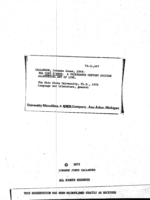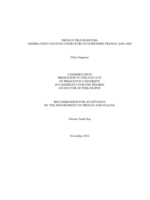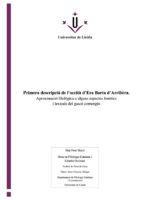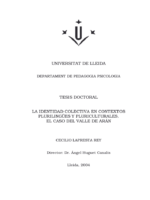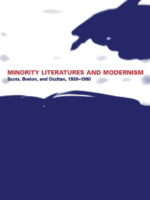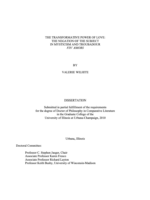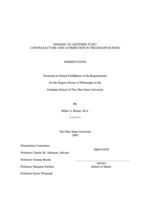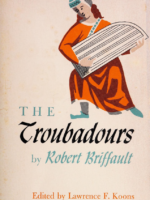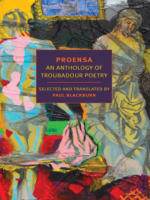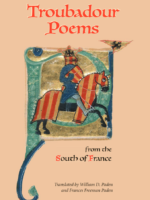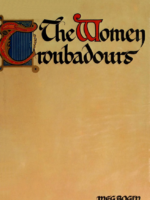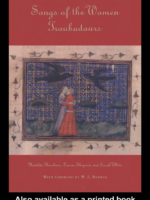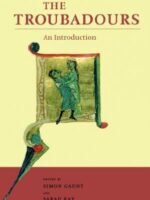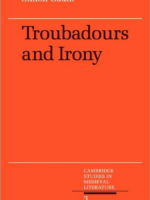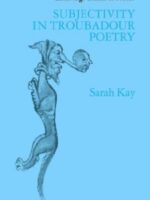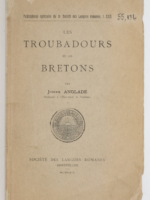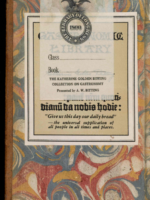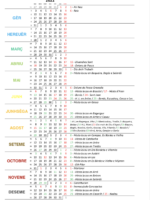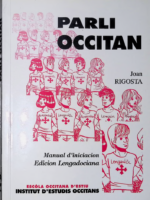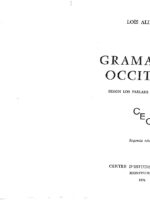Recommended Books
-
The “Cort d’Amor”: A Thirteenth Century Occitan Allegorical Art of Love
0,00 €With the exception of the romance of Flamenca, and to a lesser extent, the Arthurian romance of Jaufre. the medieval Occitan narrative poems of the thirteenth century have attracted very little scholarly attention, and among the shorter novas, only one, the Castla-gllos by Raimon Vidal, has been published recently. No full length study of Occitan allegory has yet appeared, al though one scholar,. Marc-RenS Jung, did devote one chap te r to th is topic in a broad survey of the medieval allegorical poem: Etudes sur le poeme allégorlque en France au rao.yen age. Unfortunately, nearly all studies of medieval allegory that have appeared In the last two decades take one or another of the great epic allegories like The Romance of the Rose. The Divine Comedy, or The Canterbury Tales, as. either point of departure or point of arrival, and as a result, the ensuing source studies or definitions are inevitably distorted by the magnetic field that such masterpieces ordinarily deploy. This tendency is particularly disappointing (in view of the fact that the Occitan allegories are, for the most part, earlier than the Romance of the Rose of Guillaume de Lorris, the first of these epic allegories. For this reason, if for no other, they deserve to be considered for and .by themselves.
-
French troubadours: assimilating Occitan literature in northern France (1200-1400)
0,00 €French Troubadours explores the reception of Occitan lyric in France in the thirteenth and fourteenth centuries, that is, in the period corresponding to the Albigensian Crusade (1209–1229) and its aftermath, which witnessed France’s annexation of the majority of Occitania. Surveying the corpus of French romances that quote Occitan song (Part I) and French songbooks that also contain Occitan lyrics (Part II), it shows how Occitan poems–from the very beginning of their French reception–were subtly incorporated into the French canon by way of imitation, compilation with French texts, and adaptation to the French sound system.
Chapter 1, on Jean Renart’s Roman de la rose, shows how the troubadours are collapsed into a set of francophone lyrics, which are enjoyed not in France but by the Holy Roman Emperor. French-language lyric, and other forms of French culture, are presented as the degre zero of culture in the German Empire, while Germanic languages are treated as foreign. In Chapter 2, I turn to Gerbert de Montreuil’s Roman de la violette, which, like Renart’s Rose, appropriates troubadour lyrics linguistically, and–in one instance–also associates them with the Holy Roman Empire. Here, however, the Holy Roman Empire is not a neutral cadre, but a negative space. Chapter 3, devoted to Richard de Fournival’s Bestiaire d’amour, shows how Richard obscures the first-person language and rhyme of the troubadour poems he quotes.
In Part II, I turn to the set of French songbooks that transmit Occitan lyric. A study of compilation patterns reveals that, rather than being transmitted in a separate section of songbooks, Occitan poems–which are often Gallicized–are almost always interspersed with French lyrics. Consequently, a medieval reader who encountered the troubadours only in French transmission would have little chance of recognizing their cultural specificity. In Chapter 5, I explore the “pseudo-Occitan” corpus, which comprises pieces that contain Occitan phonological coloring but were probably composed by francophones. I show that these pieces occur primarily in a lower register. This trend fictionally repositions Occitan lyric as both “primitive” and–by extension–as anterior to French lyric.
-
-
Primera descripció de l’occità d’Era Barta d’Arribèra
0,00 €Dins del domini gascó, i alhora reflectint la situació occitana general, hi ha una variació interna notòria entre les diferents varietats que omplen el territori. En aquest sentit, el comengès, que enclavem en el gascó pirinenc oriental (subdialecte que abasta una zona que comprèn la Vall d’Aran, l’àrea de La Varossa, el Comenge meridional i el Coserans), es diferencia d’una manera prou evident d’altres variants més occidentals, justament per la seua condició de parlar fronterer, situat en una zona interferencial, en paraules de Bèc (1968), entre el gascó i el llenguadocià. El treball que prossegueix mira de fer una descripció d’alguns aspectes fonètics i lexicals d’un dels municipis de parla comengesa, Era Barta d’Arribèra, localitzada estratègicament a pocs quilòmetres de Sent Gaudenç, capital històrica del Comenge i de l’antiga comarca del Nebosan.
-
La Identidad colectiva en contextos plurilingües y pluriculturales
0,00 €La comarca del Valle de Arán se encuentra situada en el extremo nor-occidental de la provincia de Lleida, en plenos Pirineos. En las últimas décadas, esta comarca está experimentando un profundo proceso de transformación sociodemográfica y cultural.La situación viene determinada por varios aspectos:
A,- Un fuerte incremento de población, proveniente principalmente de la inmigración.
B,- La coexistencia en el territorio de tres lenguas oficiales; el occitano-aranés, como lengua propia de la comarca, el catalán y el castellano.
C,- Como consecuencia de los dos primeros aspectos, una situación de contacto entre lenguas y culturas diferenciadas.Con este marco de fondo, en nuestra investigación nos proponemos analizar el proceso de construcción de la identidad colectiva en el territorio. A partir del uso combinado de técnicas de investigación social cuantitativas y técnicas de investigación social cualitativas, se demuestra el importante papel que juega la lengua propia, tanto en la definición de la identidad colectiva aranesa como en su proceso de construcción. La articulación de este fenómeno con la situación social de la lengua, caracterizada por su situación minorizada, una conciencia de reisgo real de pérdida de su función comunicativa y, asociada a ella, de su función simbólica, permite comprnder la génesis de actitudes, acciones e incluso diferentes conflictos sociales que se producen en el territorio.
-
Minority Literatures and Modernism: Scots, Breton, and Occitan, 1920-1990
0,00 €A quiet renaissance has been unfolding in certain parts of Europe – a renaissance of literature written in minority languages. In this book, William Calin explores the renaissance through an examination of twentieth-century works in Scots, Breton, and Occitan minority languages flourishing inside the borders of the United Kingdom and France.
For each of the three bodies of literature Calin considers major authors whose works include novels, poetry and plays, and shows that all three literatures have evolved in a like manner, repudiating their romantic folk heritage and turning instead to modern and postmodern concerns. Drawing on current critical theories in periodization, postcolonialism and cultural studies, Calin raises a range of comparative questions: Is there a common form of narrative prevalent in minority cultures that is neither realism nor metafiction? Is the minority-language theatre limited to plots treating past history and the rural present? What is the relationship between the minority literature and literature in the national language? What kind of history should be written on the literatures of Scotland, Brittany and the South of France, manifest in their several languages?
Calin’s pioneering study is the first comparative scrutiny of these minority literatures and the first to bring all three together into the mainstream of present-day criticism. His work demonstrates the intrinsic importance in their twentieth-century renewal, as well as their contribution to global culture, in both aesthetic and broadly human terms.
-
Songs of the Women Trouvères
0,00 €We bring together here the songs of all medieval women whose names are recorded in the rubrics or tables of contents of various Old French manuscripts as composers of songs or as participants in jeux-partis and tensons (debate poems). The songs by women whose names are known are relatively few in number, but there were undoubtedly many more women composers, and whereas their names are lost to us, some of their songs are probably still extant, though bereft of proper attribution. Accordingly, we have chosen to include a generous sampling of anonymous works—chansons de femme (women’s songs), rondeaux, and motets—both because they offer a wide variety of female voices and because some of these pieces may well have been composed by women. We hope in this way to rectify a situation that for many years has denied women their rightful place in the pantheon of Old French medieval lyric poets.
For, as surprising as it may seem, the very title of our anthology, Songs of the Women Trouvères, makes a bold, even controversial, statement. Although nearly all scholars now acknowledge the existence of medieval women who composed poetry in other romance languages (Occitan, Spanish, Italian, Galician- Portuguese), most have accepted without question Pierre Bec’s contention that none of the songs composed in northern France in the twelfth or thirteenth centuries are the product of a woman trouvère (Bec 1979: 236). A number of Old French songs feature women’s voices ( féminité textuelle), particularly in the lyric type known as the chanson de femme. However, féminité textuelle does not necessarily imply female authorship (féminité génétique), to use a distinction introduced by Bec himself (1979: 235–36). The majority of these songs are anonymous, but because most of the ones that are attributed in the manuscripts are credited to a male author, Bec has concluded that no Old French songs of the period in question were composed by women. Although many have agreed with Bec, the literary history of the past 125 years includes a few dissenters who base their opinion on evidence that until recently was either ignored or not seriously considered. A brief summary of that history is instructive, as it highlights the major arguments for and against the historical existence of the women trouvères.
-
The transformative power of love
0,00 €This dissertation compares the works of select troubadours with three mystical tracts in order to present the similarities found in these two literary traditions. Mystical writings have a far longer history reaching into antiquity and continuing until the present day. The traces in the manuscript traditions situate in the late eleventh century a new poetic form in Occitan with a focus on earthly love. The love as it is described in the songs of the composers who write or sing about it comes to be called bon amors or fin’ amors, the term we use today to name the love of the troubadour tradition. The period of lyrical production in Occitan by troubadours speaking of fin’ amors does not endure more than three centuries if we begin our count with Guilhem IX (1071-1126) and close with the poet so often called the last of the troubadours, Guiraut Riquier (1254-1292). These two traditions of love literature are thus distinguished by the nature of their literary histories and also by the loves they describe. Despite this, the shape of the loves they discuss as well as the language used to speak about love are not so different.
-
Singing to another tune: contrafacture and attribution in troubadour song
0,00 €“Singing to another tune” is from Las Leys d’amors (The Laws of Love), a poetic treatise compiled by Guilhem Molinier in the first half of the fourteenth century. Guilhem’s phrase pertains to a compositional technique known to modern scholars as contrafacture, in which the troubadour fashions new lyrics after the poetic structure of a preexistent song, thereby allowing his work to be sung to the earlier melody. The technique of contrafacture is documented not only by Guilhem and contemporaneous theorists but also by the troubadours themselves, who on a number of occasions acknowledge composing a poem “el so de,” or “to the tune of” another composer. Both theory and practice demonstrate that structural imitation came to be most closely associated with several specific genres, including the sirventes (moralizing piece), tenso (debate song), coblas (song of few strophes), and planh (lament), their poetic structures commonly modeled after those of the canso, the dominant genre of troubadour composition. Despite abundant structural indications of contrafacture within the troubadour repertoire, melodic traces of the practice are surprisingly scant. Confirmation of melodic borrowing depends upon the preservation of a model and its contrafactum with their concordant musical readings, yet the small proportion of surviving troubadour melodies (with only one in ten lyric texts transmitted with its tune) poses a significant impediment to melodic corroboration. Only three sirventes have been preserved with melodies that duplicate those of preexistent cansos. In the remaining instances in which a sirventes, tenso, or other imitative type is preserved with a melodic unicum, scholars of troubadour song have tended to maintain that, absent melodic corroboration, the tune must be presumed original rather than borrowed. In view of the sparseness of the musical record, however, one should give consideration to an alternate interpretation, namely that the tune preserved exclusively with a given troubadour’s sirventes and thereafter transmitted as his invention may actually have been borrowed from a preexistent canso whose melody is no longer extant in its original setting. Isolating viable structural models for such suspected contrafacta allows the possibility of reascribing potentially borrowed melodies to their original composers. The study of contrafacture can thus lead us to question the received attributions of a number of tunes, thereby posing a challenge to the readily made assumption that the manuscript rubrics consistently pertain to both text and melody. By examining several suspected cases of contrafacture within a web of relevant indices– e.g., generic norms, intertextual correlations, socio-historic context, rhetorical motivation, transmission, and melodic style– we gain greater insight into a compositional technique that indelibly marked the art of the troubadours.
-
The Troubadours
0,00 €Combining extraordinary learning with grace of style, this volume provides the first comprehensive work in English on the poetic heritage of the medieval troubadours and the particular impact of the troubadour tradition on Italian and English verse. The songs of the troubadours with their intense lyricism “answered the mood of a feudal society newly awakened to a sense of its native uncouthness by contact with the luxury of the Orient.”
-
Proensa: An Anthology of Troubadour Poetry
0,00 €It was out of medieval Provence – Proensa – that the ethos of courtly love emerged, and it was in the poetry of the Provençal troubadours that it found its perfect expression. Their poetry was also a central inspiration for Dante and his Italian contemporaries, propagators of the modern vernacular lyric, and seven centuries later it was no less important to the modernist Ezra Pound. These poems, a source to which poetry has returned again and again in search of renewal, are subtle, startling, earthy, erotic, and supremely musical.
The poet Paul Blackburn studied and translated the troubadours for twenty years, and the result of that long commitment is ‘Proensa’, an anthology of thirty poets of the eleventh through thirteenth centuries, which has since established itself not only as a powerful and faithful work of translation but as a work of poetry in its own right. Blackburn’s ‘Proensa’, George Economou writes, “will take its place among Gavin Douglas’ ‘Aeneid’, Golding’s ‘Metamorphoses’, the Homer of Chapman, Pope, and Lattimore, Waley’s Japanese, and Pound’s Chinese, Italian, and Old English.”
-
Troubadour Poems from the South of France
0,00 €The poetry of the troubadours was famous throughout the middle ages, but the difficulty and diversity of the original languages have been obstacles to its appreciation by a wider audience. This collection aims to redress the situation, presenting English verse translations in contemporary idiom and a highly readable form. It includes some 125 poems, with a strong representation of those composed by women, and goes beyond traditional limits in time to feature a sampling of the earliest texts in the Occitan language, written in the tenth and eleventh centuries, and later works from the early fourteenth. Though most poems translated in the book were written in Occitan, the vernacular of southern France, there are also a few translations of poems written in the same place and time but in other languages, including Latin, Hebrew, Norse, Catalan, and Italian. Genres include love songs, satires, invectives, pastourelles, debates, laments, and religious songs. A comprehensive introduction places the troubadours in their historical context and traces the development of their art; headnotes introduce each poet, and the book ends with a bibliography and suggestions for further reading.
-
The Women Troubadours
0,00 €This is the first twentieth-century study of the women troubadours who flourished in Southern France between 1150 and 1250 — the great period of troubadour poetry. The book is comprised of a full-length essay on women in the Middle Ages, twenty-three poems by the women troubadours themselves in the original Provencal with translations on facing pages, a capsule biography of each poet, notes, and reading list.
-
Songs of the Women Troubadours
0,00 €An edition and translation of some 30 poems by the trobairditz, a remarkable group of women poets from the 12th and 13th centuries, who composed in the style and language of the troubadours.
-
The Troubadours: An Introduction
0,00 €This book offers a general introduction to the world of the troubadours. Its sixteen chapters, newly commissioned from leading scholars in Britain, the United States, France, Italy and Spain, trace the development of troubadour song (including music), engage with the main trends in troubadour scholarship, and examine the reception of troubadour poetry in manuscripts and in Northern French romance. A series of appendices offer an invaluable guide to more than fifty troubadours, to technical vocabulary, to research tools and to surviving manuscripts.
-
Troubadours and Irony
0,00 €From Petrarch and Dante to Pound and Eliot, the influence of the troubadours on European poetry has been profound. They have rightly stimulated a vast amount of critical writing, but the majority of modern critics see the troubadour tradition as a corpus of earnestly serious and confessional love poetry, with little or no humour. Troubadours and Irony re-examines the work offiveearly troubadours, namely Marcabru, Bernart Marti, Peire d’Alvernha, Raimbaut d’Aurenga and Giraut de Borneil, to argue that the courtly poetry of Southern France in the twelfth century was permeated with irony and that many troubadour songs were playful, laced with humorous sexual innuendo and far from serious; attention is also drawn to the large corpus of texts that are not love poems, but comic or satirical songs. New interpretations of many problematic troubadour poems are offered; in some cases the received view of a troubadour’s work is questioned. New perspectives on the tradition as a whole are suggested, and consequently on courtly culture in general. The author addresses the philological problems, by no means negligible, posed by the texts in question, and several poems are re-edited from the manuscripts.
-
Subjectivity in Troubadour Poetry
0,00 €The medieval troubadours of the South of France profoundly influenced European literature for many centuries. This book is the first full-length study of the first-person subject position adopted by many of them in its relation to language and society. Using modern theoretical approaches, Sarah Kay discusses to what extent this first person is a “self” or “character,” and how far it is self-determining. Kay draws on a wide range of troubadour texts, providing many close readings and translating all medieval quotations into English. Her book will be of interest both to scholars of medieval literature, and to anyone investigating subjectivity in lyric poetry.
-
Les troubadours et les Bretons
0,00 €Joseph Anglade siguec professor ena Universitat de Tolosa.
L’idée du présent travail date de plus de vingt-cinq ans..

